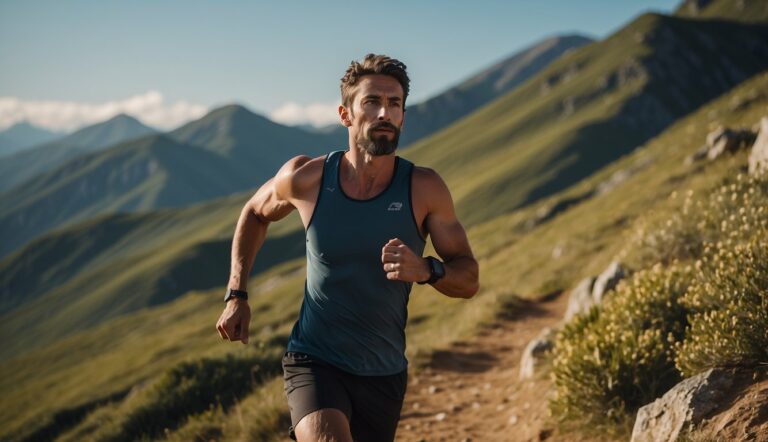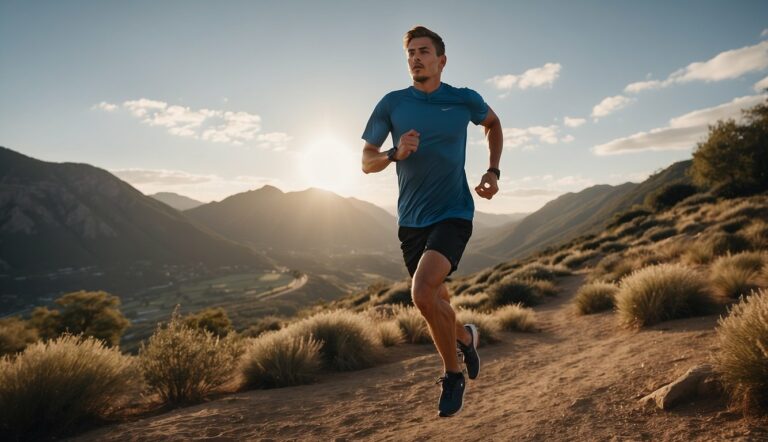The Role of Compression Gear in Trail Running: An Analysis of Advantages and Limitations
As a UESCA certified running coach with practical experience in trail running, I’ve seen the rise in popularity of compression gear among athletes looking to enhance their performance. Compression gear, designed to apply a specific amount of pressure to the limbs, is commonly worn by trail runners for potential performance benefits and protective qualities. The theory is that this gear can promote blood circulation, reduce muscle oscillation, and provide support which may all contribute to improved running economy.
However, the advantages of wearing compression gear during a trail run aren’t a universal experience. Each athlete’s body responds differently, with some reporting a perceived reduction in fatigue and muscle soreness, while others notice little to no change. It’s also important to consider the psychological aspect, as some runners feel more prepared and confident while wearing compression garments.
Despite the mixed scientific backing regarding the efficacy of compression gear, I advise runners to test different types of gear in training scenarios. This personal trial can help determine if compression clothing provides any individual advantages, such as comfort or confidence on the trails, before committing to use it in competition.
The Science Behind Compression Gear for Trail Runners
Compression gear is crafted to enhance athletic performance and recovery by focusing on blood circulation, muscle stability, and the recovery process. I’ll detail how these garments benefit trail runners based on physiology and recent studies.

Enhancing Blood Circulation
Blood flow is critical for delivering oxygen to working muscles and removing lactate, a byproduct of exercise. Compression garments apply graduated pressure to limbs which can boost venous return, helping blood circulate back to the heart more effectively. This process can potentially reduce the onset of muscle fatigue during long trail runs.
Table 1: Effects of Compression on Blood Flow
| Aspect | Without Compression | With Compression |
|---|---|---|
| Blood Circulation | Normal | Enhanced |
| Oxygen Delivery | Standard | Potentially Improved |
| Lactate Clearance | Normal | Potentially Faster |
Reducing Muscle Oscillation
During running, our muscles experience vibration, known as muscle oscillation, which can contribute to fatigue and muscle damage. By snugly wrapping the muscles, compression gear is proposed to reduce the extent of these vibrations. This support may help in minimizing the risk of microtrauma to the muscles during the repetitive impact of trail running.
- Benefit: Minimized muscle vibration
- Outcome: Less muscle trauma and reduced soreness
Supporting Recovery Process
Post-exercise, wearing compression garments might aid the recovery process by decreasing inflammation and muscle soreness. Studies suggest that this can lead to quicker muscle repair and a feeling of improved readiness for the next session. I’ve noticed that athletes wearing compression gear report feeling less sore the day after a tough trail run.
Key Points
- Compression gear may accelerate recovery.
- Wearing these garments post-exercise can help reduce muscle soreness.
In my experience as a UESCA certified running coach and trail runner myself, I’ve observed that runners who incorporate compression gear often speak to these benefits, and while individual results can vary, these garments are based on solid principles of exercise physiology.
Practical Application in Trail Running
When considering compression gear for trail running, the right selection can contribute to your performance and comfort on the trails. Let’s take a look at how to choose and use compression apparel effectively in trail running contexts.
Compression Apparel Selection
Compression Socks: For trail runners, compression socks are not just about comfort but also about reducing fatigue and the likelihood of injuries. Trusted brands like CEP, 2XU, and Zensah offer socks designed to offer targeted support to the calves and shins.
- CEP: Known for their precise millimeter of mercury (mmHg) measurements that cater to a runner’s calf size for optimal pressure.
- 2XU: Delivers compression socks with a focus on graduated compression, supporting circulation from the ankle upward.
- Zensah: Offers socks with a fabric blend that aims to reduce odor and moisture while maintaining constant pressure.
Compression Tights and Sleeves: When choosing tights or sleeves, consider the intensity of the trail and the specific muscle groups that will be most engaged. Brands like CW-X offer products with kinesiology-inspired designs that claim to target joint and muscle support, an added advantage on unpredictable terrains. Skins compression tights are engineered to increase oxygen delivery to active muscles and are popular among experienced runners for both training and recovery.
Optimizing Performance with Gear
To get the most out of compression gear for performance enhancement, it is crucial to wear them correctly and at appropriate times. Compression tights should fit snugly, without restricting movement or being uncomfortable. Wearing them during long trail runs may help stabilize muscles and reduce vibration, potentially decreasing muscle fatigue.
- Before a Trail Run: Pre-wear your compression tights or sleeves to warm-up muscles and increase blood flow.
- During a Trail Run: Select gear that provides the right level of compression and support based on the trail difficulty and expected conditions.
- Post-Trail Run: Use compression socks to aid in recovery. The gentle pressure helps facilitate blood flow, which can speed up the removal of metabolic waste from the muscles.
Incorporate compression gear into your trail running regimen to potentially bolster muscle support and enhance recovery. Remember that while compression gear can aid in performance, it should complement a well-structured training plan and proper nutrition.
Evaluating the Benefits
In my experience as a UESCA certified running coach, trail runners often turn to compression gear to enhance their performance and recovery. Let’s explore how this equipment may benefit your trail running regimen.
Improving Running Economy
Compression gear, like tights or socks, supports muscles through a mechanism similar to wrapping an item securely to prevent movement. Muscle vibration from impact is reduced, potentially decreasing the amount of energy expended throughout your run. Controlled studies are not unanimous but some suggest wearing compression gear could lead to modest improvements in endurance by keeping muscles optimally aligned and efficient.
Delaying Muscle Soreness
The theory behind compression gear is its ability to promote blood flow, which could reduce muscle damage after strenuous workouts. As an outcome, runners might experience delayed onset of muscle soreness, potentially maintaining a higher level of endurance during longer trail runs. Support from compression apparel might also minimize muscle fatigue, allowing you to preserve your energy and tackle those challenging inclines.
Enhancing Comfort and Stability
Beyond muscle support, compression gear is designed to offer graduated compression, which varies the pressure along the limb. It’s crafted to be tighter in areas farthest from the heart to help in the return of blood flow.
This can enhance overall comfort over long distances. Additionally, the snug fit has the benefit of reduced chafing since there is less fabric movement against the skin. Stability is key during trail running, and the muscle support provided by the right gear may improve movement and reduce the risk of trips and falls.
In my running journey, I’ve found that each individual’s response to compression gear can vary widely. It’s essential to consider personal comfort and preference along with these potential benefits when selecting your running apparel.
Recognizing the Limitations and Risks
While compression gear can assist trail runners by supporting muscles and enhancing circulation, it’s important to be aware of its limitations and potential risks when used incorrectly.
Potential for Overreliance
One potential issue is overreliance. Some runners might rely too much on compression gear as a crutch for muscle weakness or injury prevention. I advise that compression gear should complement, not replace, proper training and recovery protocols. Remember, no gear can substitute for a well-structured training plan.
- Drawbacks: Can lead to neglect of proper workout and recovery techniques
- Muscle damage: Overdependence may mask pain and lead to ignoring serious injuries
Understanding Compression Levels
The effectiveness of compression gear often hinges on proper compression levels. Wearing gear that’s too tight can cause discomfort or even worse, blood clots or deep vein thrombosis (DVT). It’s critical to ensure the gear fits well and provides the correct level of pressure, not too loose, nor too restrictive.
- Inflammation: Appropriate compression levels can aid in reducing inflammation; however, incorrect levels might exacerbate it
- Discomfort: Ill-fitting compression wear can lead to chafing or skin irritation
Avoiding Misconceptions in Usage
Compression gear is not a panacea for all issues. It won’t wholly prevent muscle damage or eliminate the risk of DVT. There’s also no definitive evidence that it prevents varicose veins. My advice is to use compression gear with a clear understanding of what it can and cannot do, and never ignore the body’s signals just because you’re wearing it.
- Blood clots: While gear can improve circulation, it should not be solely relied on to prevent clots
- Varicose veins: Gear may assist in managing symptoms but it is not a cure for varicose veins
Additional Considerations for Athletes
As an expert and UESCA certified running coach, I’ve seen the real impact of compression gear on trail running. This section will assist athletes in optimizing their use of compression apparel for maximum benefit.
Incorporating Gear into Training Regimes
When introducing compression gear into a training regimen, I recommend a gradual approach.
Start using the gear during low-intensity workouts to assess comfort and effectiveness. The gear can help reduce muscle soreness and fatigue, which is especially beneficial after a long run. Monitor your body’s response closely—look for changes in muscle recovery time and any reduction in swelling or cramps.
Relevance to Other Endurance Sports
Compression gear isn’t exclusive to trail running; it’s applicable across various endurance sports. The principles of improved oxygen delivery and enhanced joint stability from compression wear apply to activities like marathons and long-distance cycling, too. Athletes in these sports might also experience improved proprioception—awareness of the body in space—which is critical for maintaining form and preventing injuries over long distances.
Integrating Professional Guidance
My role as a coach includes guiding athletes on how to strategically use compression apparel. Personalized coaching services can help determine the right balance of workout intensity and recovery time.
Additionally, consulting a professional can provide insights on using compression gear during travel to races, which may help manage inactivity and its associated risks. Remember, each athlete’s response to compression gear is unique, and professional guidance can optimize its use.
I advise staying in tune with your body’s signals and incorporating professional suggestions to make the most out of compression gear in your athletic pursuits.





